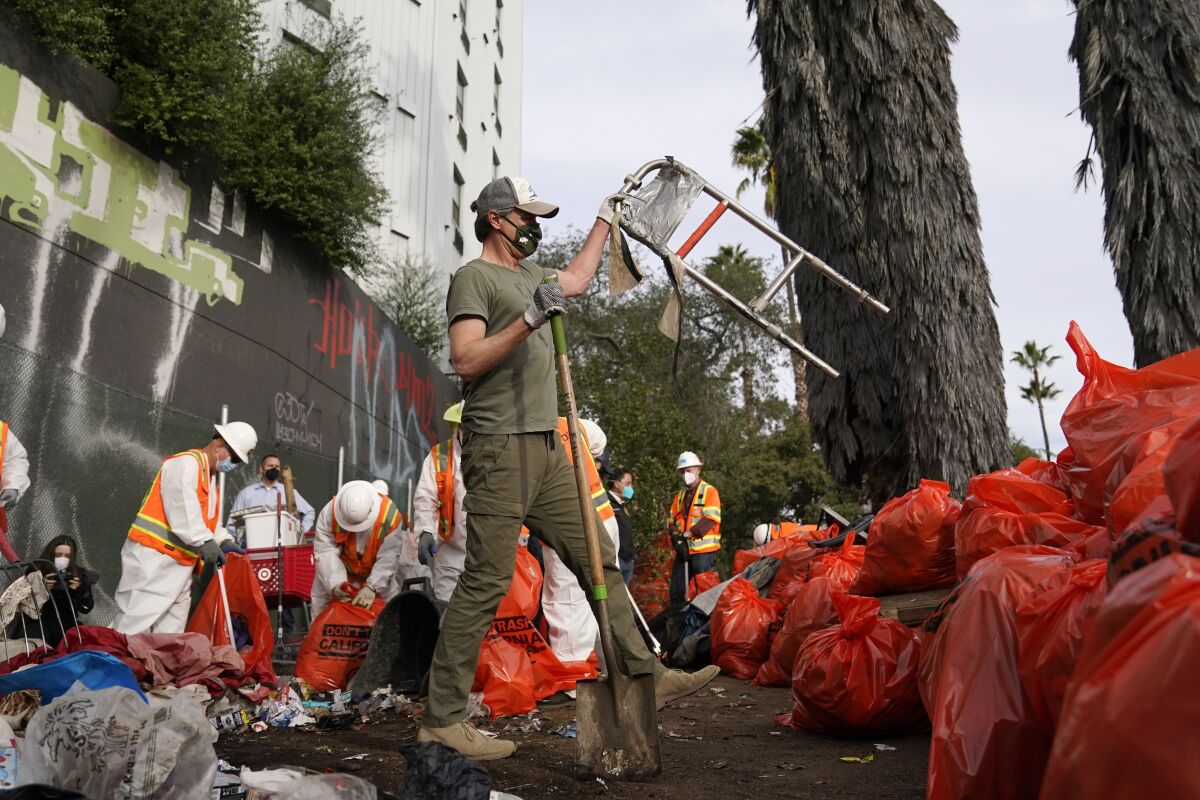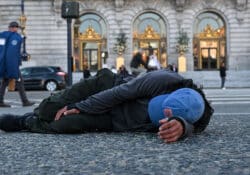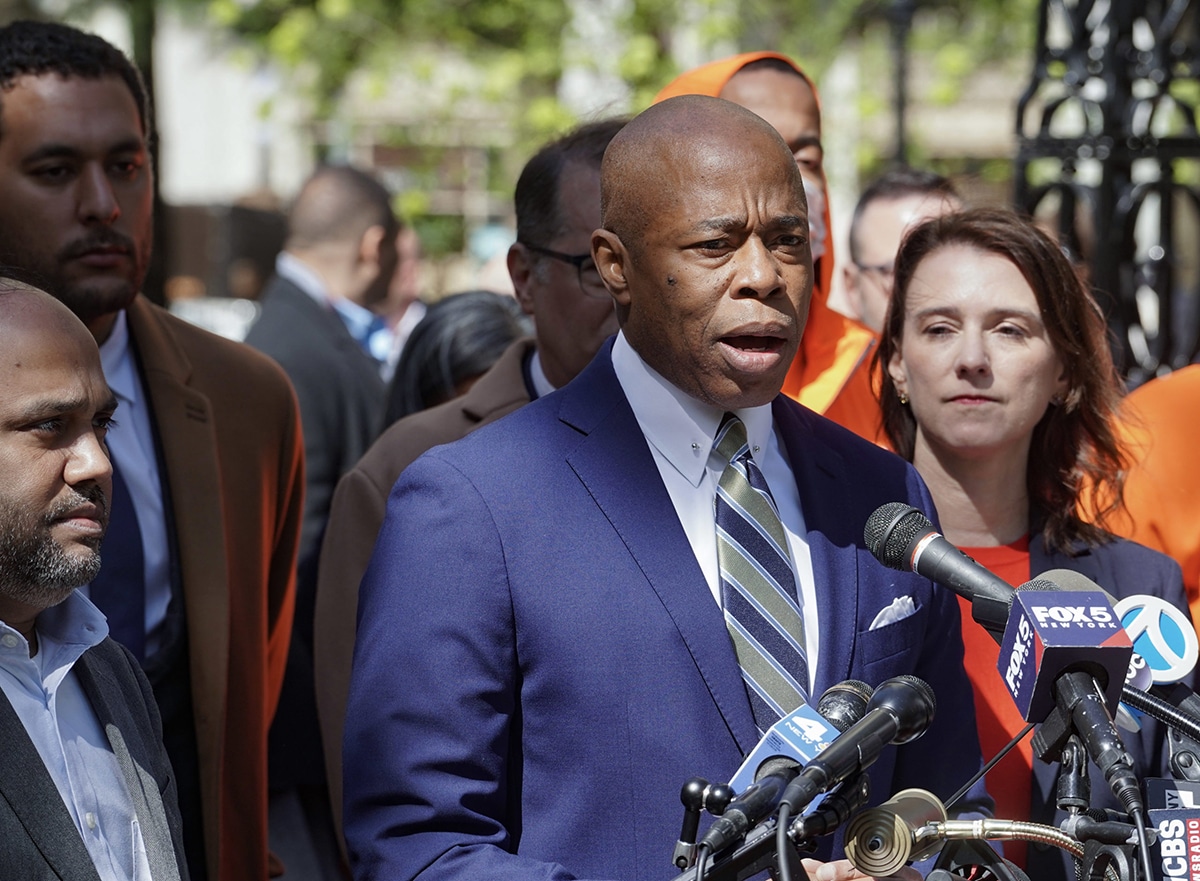

California’s Plan to Disappear the Homeless
by Conor Gallagher | Jan 28, 2023
Elected officials continue to turn to draconian measures to disappear homeless people. In addition to passing a wave of laws across the country criminalizing homelessness, California is moving ahead with a plan that will allow the state to force the unhoused into court-ordered treatment programs for a period of up to two years – and potentially much longer. (New York is is considering a similar law.)
The California law is not designed to actually help the homeless or stop more people from becoming homeless, which would actually require resources and/or taking on powerful interests like the private equity-dominated real estate rental market, the healthcare industry that bankrupts people, major corporations that pay poverty wages, etc. Let’s remember that 40-50 percent of people experiencing homelessness are employed. Instead these laws are simply designed to remove from view the people our society has chewed up.
The criminalization route allows politicians to look tough and say they’re doing something (and maybe eventually it means the homeless can help make money for the private prison industry and/or become slave laborers to help line the pockets of some of the largest and most profitable companies in the US). The court-ordered treatment policies allow politicians like California Governor Gavin Newsom to preen himself for being compassionate. So naturally the California law is called the CARE (Community Assistance, Recovery and Empowerment) Act.
CARE is slated to start rolling out later this year, but the plan is still facing opposition in the courts. Just this week Disability Rights California and other civil rights and disability advocates filed a lawsuit against Newsom in an attempt to overturn the law. They say it violates constitutional guarantees of due process and equal protection as well as the fundamental rights to privacy, autonomy and liberty.
So what exactly does CARE do?
Anyone from family members to first responders could petition a civil court to create a court-ordered care plan for people who meet specific criteria. These include a diagnosis of schizophrenia or other psychotic disorders, along with being at risk of harming themselves or others or being unlikely to survive on their own. Here is relevant section from state bill 1338:
An individual shall qualify for the CARE process only if all of the following criteria are met:
(a) The person is 18 years of age or older.
(b) The person is currently experiencing a severe mental illness, as defined in paragraph (2) of subdivision (b) of Section 5600.3 [1] and has a diagnosis identified in the disorder class: schizophrenia spectrum and other psychotic disorders, as defined in the most current version of the Diagnostic and Statistical Manual of Mental Disorders. [2]
(c) The person is not clinically stabilized in on-going voluntary treatment.
(d) At least one of the following is true:
(1) The person is unlikely to survive safely in the community without supervision and the person’s condition is substantially deteriorating.
(2) The person is in need of services and supports in order to prevent a relapse or deterioration that would be likely to result in grave disability or serious harm to the person or others, as defined in Section 5150.
(e) Participation in a CARE plan or CARE agreement would be the least restrictive alternative necessary to ensure the person’s recovery and stability.
(f) It is likely that the person will benefit from participation in a CARE plan or CARE agreement.
As opponents of the law have pointed out, the criteria are subjective, speculative and subject to bias. One of the listed mental illnesses in paragraph (2) of subdivision (b) of Section 5600.3 is PTSD, which studies have shown is common after losing one’s home. Additionally, one could argue that anyone who is homeless is at risk of harming themselves or being unlikely to survive. It is well-established that poverty and homelessness can lead to or worsen physical and mental health, and the life expectancy of homeless individuals in LA County as of 2019 was 48 for women and 51 for men – compared to the 83 and 79 among the general population.
It also means that police tasked with “sweeping” areas of homeless people now have a powerful new tool at their disposal. County behavioral health agencies can also file petitions with the court for involuntary treatment, which will create obvious conflicts of interest as these agencies’ funding will be affected by CARE levels.
Any homeless individual swept up into CARE could receive legal counsel, mental health services, medication, and “may” be provided housing. After one year, the participant/prisoner could either “graduate” or be required to undergo an additional year of treatment. Any refusal to comply, or “failing out,” and the court could impose conservatorship, which would allow an individual or potentially the state to make medical and financial decisions, subject them to forcible medical treatment and medication, and control all basic life choices like where to live and whether to marry. It could also pave the way to detention.
Forcing homeless Californians into conservatorship would be condemning them to a system that is already rife with problems. From CalMatters:
“Having a situation with very little oversight where one person has extraordinary control over another person is just a recipe for abuse,” said Brennan-Krohn of the ACLU. …
Critics of the probate system, in particular, have long warned of abuse. In 2005, the Los Angeles Times published an investigation highlighting widespread abuses within the conservatorship system. In response, the Legislature passed a series of revisions in 2006. But many of the promised changes and increased oversight were never funded due to the 2008 economic recession.
Forcible medical treatment and medication also raises all sorts of red flags. Journalist Carl Elliott writes about how the destitute and the mentally ill have long been used as human lab rats to test out all sorts of medications and treatments. They’re usually recruited and paid by private research sites based in strip malls or suburban office parks that specialize in testing psychiatric drugs. Pharmaceutical companies typically outsource clinical studies to the private research companies, which run trials faster and at lower cost than universities do. The companies target the homeless because they might be desperate enough to participate in risky drug trials in exchange for a few thousand dollars. Elliot explains:
Most trials have to be studied by a review board, and that includes studies that use homeless people. The boards could take a stand against the practice, and perhaps some do. Finding out is next to impossible, because both the FDA and the for-profit boards regard many of the records associated with clinical trials as commercial secrets. Even the name of the board that reviewed a trial is confidential. This secrecy means that it is hard to determine whether reviewers even know where trial sites are recruiting their subjects. There’s also a conflict of interest to consider: Perhaps review boards don’t ask too many questions, because a board may start losing customers if it gets a reputation for being too strict. …
Some prominent bioethicists do not see homelessness as a barrier to research. When The Wall Street Journal reported in 1996 that the pharmaceutical company Eli Lilly was recruiting homeless alcoholics for research studies, Lilly responded by hiring an expert bioethics panel led by Tom Beauchamp of Georgetown University. The panel argued that not only was testing drugs for safety on homeless people reasonable, provided proper procedures were followed, but also that “it would be unfair to exclude homeless persons categorically as a group.” Beauchamp and another panelist, Robert Levine of Yale, went on to become paid ethics consultants for Lilly.
The CARE law only requires that the medications an individual in the program is forced to take are “clinically appropriate.” It adds that “‘stabilization medications’ means medications included in the CARE plan that primarily consist of antipsychotic medications, to reduce symptoms of hallucinations, delusions, and disorganized thinking.”
In California’s case, the potential number of homeless people that could be forced into the CARE program and onto medications is massive. The number of homeless in the state increased by at least 22,500 over the past three years, to 173,800 (out of 582,462 across the country). Both are likely large undercounts. Since the US doesn’t really care about the homeless aside from finding ways to profit off them or keeping them out of the public eye, the numbers are collected by volunteers every other year on a given winter’s night, which naturally misses many.
Even if California was theoretically able to push all its homeless into conservatorship and out of view, it does nothing about the increasing number of people joining the ranks of the homeless. CARE does not boost permanent supportive housing or mental health care. It relies on existing programs and service providers that are already overwhelmed. The only new money in the law goes to the courts.
Despite mental health professionals warning that forced treatment programs do more harm than good and local governments complaining they don’t have the capacity, the politicians in Sacramento pushed it through anyways.
What CARE will essentially do is restructure homelessness efforts in the state to prioritize people in the CARE program at the detriment of others seeking non-coerced help. This is about the worst possible strategy – if your goal is to actually help the homeless.
If the goal is to disappear them, it could prove highly effective. A recent study, “Use of Coercive Measures during Involuntary Psychiatric Admission and Treatment Outcomes: Data from a Prospective Study across 10 European Countries,” found that “all coercive measures were associated with patients staying longer in the hospital.” In California’s case, that means that CARE “graduation” rates are likely to be low, which makes conservatorship more likely.
Organizations like the ACLU and Human Rights Watch point out that the law violates international human rights treaties. HRW opposed the CARE law, writing:
The Convention on the Rights of Persons with Disabilities establishes the obligation to “holistically examine all areas of law to ensure that the right of persons with disabilities to legal capacity is not restricted on an unequal basis with others. Historically, persons with disabilities have been denied their right to legal capacity in many areas in a discriminatory manner under substitute decision-making regimes such as guardianship, conservatorship and mental health laws that permit forced treatment.” The US has signed but not yet ratified this treaty, which means it is obligated to refrain from establishing policies and legislation that will undermine the object and purpose of the treaty, like creating provisions that mandate long-term substitute decision-making schemes like conservatorship or court-ordered treatment plans.
The World Health Organization has developed a new model that harmonizes mental health services and practices with international human rights law and has criticized practices promoting involuntary mental health treatments as leading to violence and abuse, rather than recovery, which should be the core basis of mental health services. Recovery means different things for different people but one of its key elements is having control over one´s own mental health treatment, including the possibility of refusing treatment.
To comport with human rights, treatment should be based on the will and preferences of the person concerned. Housing or disability status does not rob a person of their right to legal capacity or their personal autonomy. Expansive measures for imposing mental health treatment like the process envisioned by the CARE Court plan infringe on it and discriminate on the basis of disability. As discussed below they also run the risk of being abused by self-interested actors. This coerced process leading to “treatment” undermines any healing aim of the proposal.
And yet the bill to establish CARE Courts sailed through all of its policy committees in the Democrat-dominated Legislature and was unanimously approved by the Senate last year.
To recap:
- The law actively makes services for the homeless worse.
- It does nothing to address the underlying causes of homelessness.
- It pushes coerced mental health treatment, which is proven to be ineffective.
- It creates situations ripe for abuse.
But it does allow Newsom and the California Democrats to virtue signal that they CARE. And they’re not spending $30 billion preparing for the 2028 Olympics only to have the games tarnished by all the Hoovervilles. Got to get the homeless out of sight and out of mind.
Subscribe to Naked Capitalism
NOTES
[1] Paragraph (2) of subdivision (b) of Section 5600.3: For the purposes of this part, “serious mental disorder” means a mental disorder that is severe in degree and persistent in duration, which may cause behavioral functioning which interferes substantially with the primary activities of daily living, and which may result in an inability to maintain stable adjustment and independent functioning without treatment, support, and rehabilitation for a long or indefinite period of time. Serious mental disorders include, but are not limited to, schizophrenia, bipolar disorder, post-traumatic stress disorder, as well as major affective disorders or other severely disabling mental disorders. This section shall not be construed to exclude persons with a serious mental disorder and a diagnosis of substance abuse, developmental disability, or other physical or mental disorder.
[2] Diagnostic and Statistical Manual of Mental Disorders says that Schizophrenia Spectrum and Other Psychotic Disorders are “defined by abnormalities in one or more of the following five domains: delusions, hallucinations, disorganized thinking (speech), grossly disorganized or abnormal motor behavior (including catatonia), and negative symptoms”.
Delusions: Are fixed beliefs that are not amenable to change in light of conflicting evidence. May include several themes: persecutory, referential, somatic, religious, grandiose.
Hallucinations: Perception-like experiences that occur without an external stimulus. They are vivid and clear, with the full force and impact of normal perceptions, and not under voluntary control.
Disorganized Thinking: typically inferred from the individual’s speech. The individual may switch from one topic to another.
Grossly disorganized or abnormal motor behavior: Manifests itself in a variety of ways, ranging from childlike “silliness” to unpredictable agitation. Problems may be noted in any form of goal-directed behavior, leading to difficulties in performing activities of daily living.
Negative Systems: Account for a substantial portion of the morbidity associated with schizophrenia but are less prominent in other psychotic disorders. Two negative symptoms are particularly prominent in schizophrenia: diminished emotional expression and avolition.




